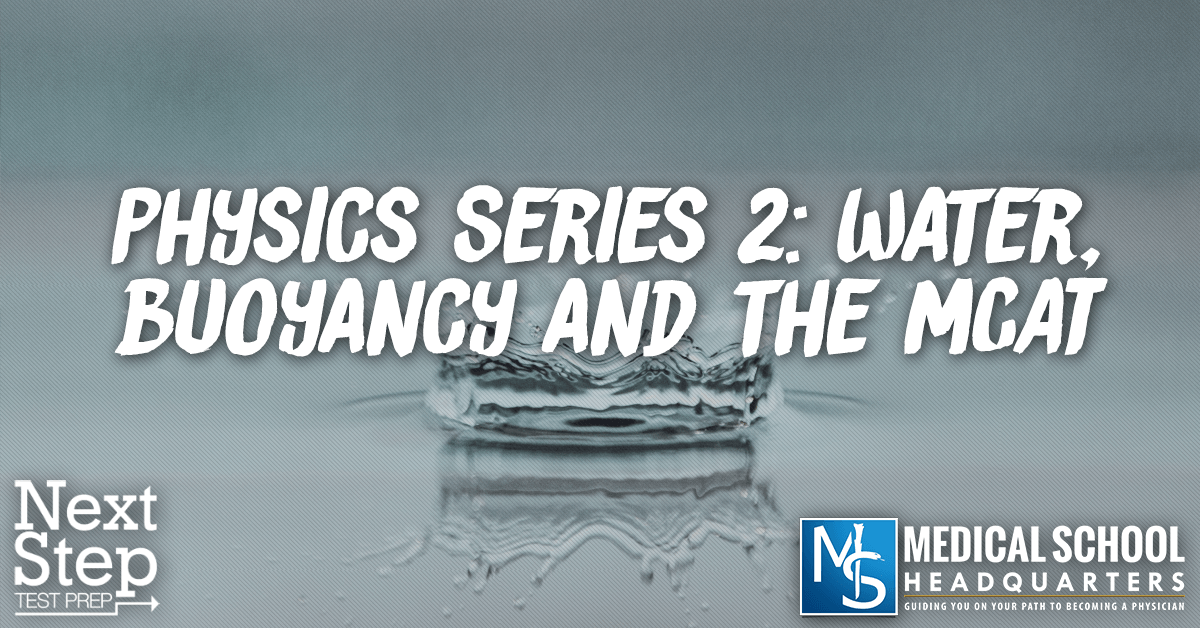You still have time to sign up with one of our amazing expert advisors! Learn More!

Water and fluid dynamics and physics go hand in hand on the MCAT. This week we’re cover this topic to help you improve your physics MCAT section score.
As always, we’re joined by Bryan Schnedeker from Blueprint MCAT (formerly Next Step Test Prep). The questions are taken from the QBank, which costs $50 if you purchased it separately. And if you purchase the ten packs of full lengths for $49, then you’re going to get the QBank for free. It’s great deal. So for $250, you’re getting ten full-length tests, so it’s $25 per test. It’s literally the best deal you can buy anywhere. The QBank has the equivalent of essentially two more full length MCAT worth with 127 passages and a thousand discrete questions and more!
Question 11: A foam life raft has a density of 491 kg/m3. When placed in a pool of pure water, what percentage of the raft’s volume will be above the surface of liquid?
You always have to follow the math where it leads you, but at the same time, the MCAT is grounded in reality, real science, the real world. So you’re pretty sure, it’s going to float. Hence, it’s going to be a, b, or c.
When they’re giving you 4.91 and 49.1, this is a strong clue that it’s not D. They’re expecting you to mess up by a factor of 10.
So there’s outside knowledge that you need here. You have to walk into the test knowing the density of water. And water’s density is 1000kg/m3. It sounds odd but people don’t realize how big a cubic meter is and it’s an enormous box. It’s very heavy. And this life raft only has a density of 491kg/m3. So a little less than half is dense. So if you put it in water, it’s going to float.
The simple rule of thumb is if you take the density of the object and divide it by the density of the fluid, that ratio is going to give you the percentage that will sink into the fluid.
Think of like a pool noodle that barely sinks into the water at all. And if you said it has a density that’s 5% of water, a density of 50kg/m3 and water has a density of 1000 kg/m3. So it’s 5% the density of water and only 5% of it sinks down into the water.
And if you think of an actual pool toy, it really does seem to rest right on the top of the water.Whereas it’s something at a density of 97% of water, it would almost entirely sink. IN this case, 491/1000 is 49.1. So this is how much it would sink. And the question asks for that which is floating above the surface, so the correct answer is (C) 50.9% that’s emerging above the water.
Tip: Always read the questions carefully. Answer the question they actually asked you.
Question: A variety of experiments are being conducted in a large tank containing an ideal fluid. A spherical object with a volume of 0.84 m3 and a specific gravity of exactly 1.05, which is true?
The rule for floating is simple. If you have a density greater than the fluid, you sink. If you have a density less than the fluid, you float. And if you have a density equal to the fluid, you just stay wherever you are right now, or you keep moving with whatever your current velocity is.
This tells us the object has a specific gravity of 1.05 but it doesn’t tell us the specific gravity of the fluid. In this case, the correct answer is (D).
Question 13: A sample of deionized water is kept in a cylindrical beaker with a radius of 4cm and a height of 10cm. The density of the water is closest to:
The reason Bryan picked this question here is to make this general point. You want to remember that on the MCAT, on the passage and even in the questions, there can be extra information.
In this case, what’s the density of water. Who cares what’s in or if it’s a beaker or it in a cup or in the ocean. Regardless, the density of water is what it is wherever it is.
As mentioned a while ago, the density of water is 1000 kg/m3. However, you need to know the other way of expressing this same notion which is 1g/cm3, 1 gm/ml, or 1kg/L. The density of water is often described as 1 because it is in three different unit analysis.
The correct answer here is (D) 1000 g/L which is just 1 kg. So that’s it.
Note that the question only required one thing and that’s you should know the density of water.
If you’re looking for full-length practice exams, go to Blueprint MCAT (formerly Next Step Test Prep) and sign up for a free diagnostic. And you also get one free full-length. They also have other full-length exams that you can purchase. You can sign up for four or six or ten exams and save 10% when you use the promo code MCATPOD.
Blueprint MCAT (formerly Next Step Test Prep) Practice Tests

Lorem ipsum dolor sit amet, consectetur adipiscing elit
I just received my admission to XXXXX! This is unreal and almost feels like I am dreaming. I want to thank you for all of your help with my application. I cannot overstate how influential your guidance and insight have been with this result and I am eternally grateful for your support!
IM SO HAPPY!!!! THANK YOU SO MUCH FOR ALL YOUR HELP, IM INDEBTED TO YOU! Truly, thank you so much for all your help. Thank you doesnt do enough.
I want to take a few moments and thank you for all of your very instructive, kind and consistent feedback and support through my applications and it is your wishes, feedback, and most importantly your blessings that have landed me the acceptance!
I got into XXXXX this morning!!!! It still has not hit me that I will be a doctor now!! Thank you for all your help, your words and motivation have brought me to this point.
I wanted to once again express my heartfelt gratitude for your help in providing feedback during my secondary applications. Your guidance has been instrumental in my journey.
Just wanted to share my wonderful news! I received my first medical school acceptance! Thank you for all that you do for us Application Academy!!!
I am excited to tell you that I just got my third interview invite from XXXXX today! I can’t believe it. I didn’t even know if I was good enough to get one, let alone three – by mid-September. Thank you so much for all of your help and support up to this point; I would not be in this position without it!!
I wanted to thank you for helping me prepare for my XXXXX interview. Even in a 30-minute advising session, I learned so much from you. Thank you for believing in me, and here’s to another potential success story from one of your advisees!
I just received an acceptance with XXXXX! This is so exciting and such a huge relief and so nice to have one of our top choice schools! I also received an interview with XXXXX which brings the total up to 20 interviews! Thank so much, none of this would have been possible without you!

Join our newsletter to stay up to date
* By subscribing you agree to with our Privacy Policy and provide consent to receive updates from our company.
Resources
Advising Services
Podcasts & Youtube
Books
About
Deal Lasts for

"*" indicates required fields